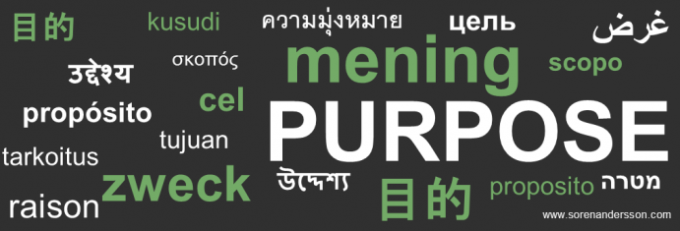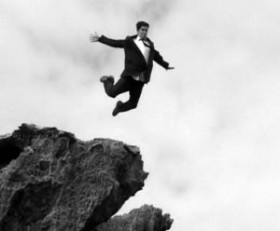
In some earlier articles I have tried to emphasize on the “problem” with incremental change, in relation to Sustainability. Here’s a new attempt.
Often when we talk about change, many people start by defining where we are, not seldom describing the current situation in great detail. The problem with this approach is that immediately you have created a huge “backpack” that you need to carry all the way, a lot of details, all in need of care during the journey…
This approach automatically creates an incremental change behavior – With so much details, few corporation has the willpower or manpower to make a total overhaul and furthermore the height of the “pile of work” itself can be depressive.
One reason many corporations find themselves in this situation is a, sometimes excessive, strive to document exactly how they do things and how things should be done. Not seldom these routines are also certified or following specific standards. (Read more HERE)
(I don’t say that this is all wrong, but it can be a hindrance and a complication.)
“Start where you need to be – not where you are!”
If you instead start where you need to be in a sustainable world you are much more likely to arrive there!
Don’t jump into assumptions…
 The assumption that your current business, with a little bit of fixing and sanding-off at the edges will be largely unaltered in a Sustainable world is likely to be wrong.
The assumption that your current business, with a little bit of fixing and sanding-off at the edges will be largely unaltered in a Sustainable world is likely to be wrong.
Why is that? – Because you want it to!
“Of course your business idea is good, that’s why you came up with in the first place…“
An example:
Let’s say that you are a car-manufacturer. The idea that you simultaneously are a car-fan is not totally unlikely…!? Then this issue with Sustainability comes up.
Now you ponder how to make your cars “more sustainable”…
– Eureka – You change the engines to low consumption, low emission diesel engines and you even make a hybrid-version, that’ll do it.
At the same time a new generation of “millennials” are growing up, a generation that is much more into iPads, computers, social interaction and that “new stuff”. Many of these are living in urbanized areas and have not even considered to drive a car, and certainly not to own one.
Question: Who is going to buy the low-emission, hybrid cars?
Question: Who is going to pay the development costs?
Now, this example is “totally fiction” [!] and has no connection to reality what so ever, but I am sure that you can come up with similar scenarios, closer to your line of business…
Transformation – Start where you need to be…
 Start by asking yourself, or your corporation
Start by asking yourself, or your corporation
– What is My/Our purpose in a sustainable world?
(You might need to add some comments like “15 years from now”…)
Don’t fall into the “assumption-trap” described in the previous example, but instead do some research and benchmarking and try to ask questions that not automatically lead to the answer you “Want to hear”.
If you are “lucky” the answer is that you have a purpose, also in a Sustainable world.
If not – that is also extremely important information…!
An example:
This time we pretend that you are a clothes manufacturer; we could say that you have a line of outdoor garments for active people, hikers, climbers etc.
On the “purpose question” you note that people most likely will be hiking also in the future Sustainable world, since it produces very little emissions, it doesn’t consume a lot of resources and it gives you relaxation, exercise and experiences at the same time.
Doing some “backward-engineering” you now realize that the clothes necessary actually do use some resources and if many people are going to do a lot of hiking, available resources will be scarce. Solution could be to design clothes that last longer and maybe even could be recycled somehow.
So you design a fabric that can be returned to the manufacturer, “melted/treated” and re-used in a new garment. While at it, you create a “deposit-system” that gives customers some pay-back if they return their used garment, and why not also a system for second-hand trade if the garment is still fully functional and a repair service.
To really get customers onboard you do some special PR-events, probably via Social media.
For instance you could ask people “Don’t buy our stuff if you not really need it!”
This example is also “totally fiction” and has “no connection to reality”, but I am sure that you can come up with similar scenarios… (you could always check what Patagonia is up to….)
Lesson learned…
Starting where you need to be gives you the opportunity to use a “helicopter view” of your situation. It will also give you a vision of what your product or service should look like in a sustainable world – maybe your current operation cannot be transformed into this in “small incremental steps”, maybe it needs some total and even inconvenient changes in the overall setup.
These “major changes” should be detected and prioritized before you start spending a lot of time, effort and money on a lot of incremental changes, small alterations in routines, documentations etc. trying to fit your current operation into a new time.
If you focus too much on “carrying your backpack”, doing “as we always have” – it might use up the resources you need for the major enevitable changes.
“Being less bad doesn’t mean you are Good – We need Transformation!”
…and you know what – it is the same with our private lives – we urgently need to leave our exaggerated consumerism and go for something better…